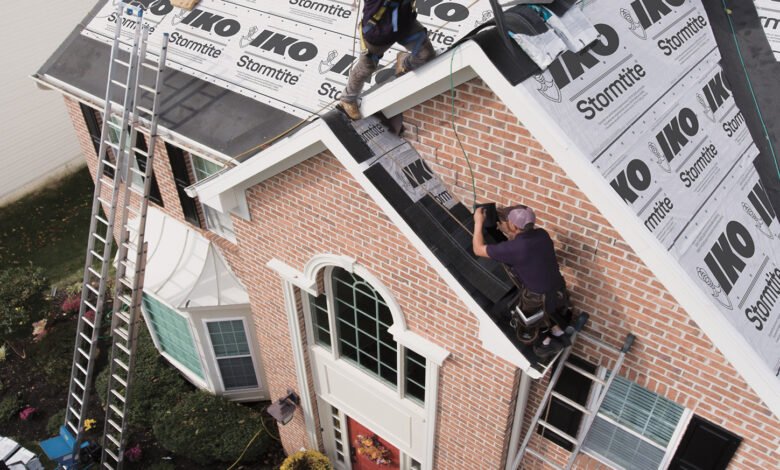What to Expect During a Roof Replacement

Your roof protects your home, but it has a limited lifespan and will eventually need replacement. This guide aims to demystify the daunting and complex process of roof replacement, covering everything from recognizing signs that your roof needs attention to understanding the step-by-step replacement process.
Signs You Need a Roof Replacement
Knowing when to replace your roof is key to preventing more severe, costly damage to your home. While a professional inspection is the best way to get a definitive answer, there are several warning signs you can look for yourself.
- Age of the Roof: Most asphalt shingle roofs last between 20 and 30 years. If your roof is approaching this age, it’s wise to start planning for a replacement, even if there are no obvious signs of failure.
- Curling or Clawing Shingles: Look at the slopes of your roof that get direct sunlight. If you notice the edges of the shingles are curling upwards or the middle is buckling, it’s a sign that they are past their prime and may be susceptible to wind damage.
- Missing Shingles: A few missing shingles after a major storm isn’t necessarily a cause for alarm, but if you consistently find shingles in your yard, it indicates a widespread problem.
- Cracked Shingles: Shingles can crack due to wind damage or age. If you see numerous cracked shingles across the roof, it’s a clear indicator that the roof is failing.
- Granules in the Gutters: When asphalt shingles start to wear out, they shed their protective granules. You might find these tiny, sand-like particles accumulating in your gutters or at the bottom of your downspouts.
- Sagging Roof Deck: A sagging roof is a serious structural issue that needs immediate attention. It could mean the underlying decking is rotting or that there are problems with the supports in your attic.
- Leaks or Water Damage: Any sign of water inside your home, such as stains on the ceiling or walls, is a major red flag. By the time a leak is visible indoors, the damage to your roof and attic could already be significant.
Choosing the Right Roofing Materials
Selecting the right material is a crucial part of the roof replacement process. Your choice will impact the cost, durability, and appearance of your home. Here are some of the most common options:
Asphalt Shingles
Asphalt shingles are the most popular roofing material in North America, and for good reason. They offer a great balance of cost, durability, and aesthetic appeal.
- Pros: Affordable, easy to install, and available in a wide range of colors and styles.
- Cons: Shorter lifespan compared to other materials (20-30 years) and can be less resistant to extreme weather.
Metal Roofing
Metal roofs, made from materials like steel, aluminum, or copper, are becoming increasingly popular due to their longevity and durability.
- Pros: Extremely durable and long-lasting (50+ years), energy-efficient, and resistant to fire, rot, and insects.
- Cons: Higher initial cost and can be noisy during rainstorms if not properly insulated.
Wood Shakes and Shingles
For a natural, rustic look, wood shakes or shingles are an excellent choice. They are typically made from cedar or redwood.
- Pros: Beautiful aesthetic that ages gracefully and offers good insulation.
- Cons: High maintenance, susceptible to rot and insects, and can be a fire hazard in some areas. They also come with a higher price tag.
Slate or Tile
Slate and clay or concrete tiles offer a premium, classic look that can last a lifetime.
- Pros: Incredibly durable and long-lasting (often over 100 years), fireproof, and low maintenance.
- Cons: Very heavy, requiring additional structural support for the roof deck. They are also one of the most expensive roofing options.
The Roof Replacement Process: A Step-by-Step Guide
Once you’ve chosen a contractor and your materials, the physical work begins. A typical roof replacement follows these steps:
- Preparation: The crew will protect your property by covering landscaping, siding, and driveways with tarps to catch falling debris. A dumpster will usually be placed in your driveway for waste disposal.
- Tear-Off: The old roofing material is completely removed down to the roof decking. This allows the crew to inspect the decking for any rot or damage that needs to be repaired before the new roof is installed.
- Decking Inspection and Repair: The wooden sheathing that makes up your roof deck is thoroughly inspected. Any soft, wet, or rotting wood is replaced to ensure a solid foundation for your new roof.
- Installation of Underlayment: A layer of synthetic underlayment or felt paper is installed over the roof deck. This acts as a secondary water barrier, protecting your home from moisture that might get under the shingles. An ice and water shield is also installed along the eaves and in valleys for extra protection.
- Installation of New Roofing Material: The new shingles, metal panels, or tiles are installed, starting from the bottom and working up. The crew will also install new flashing around chimneys, vents, and skylights to prevent leaks.
- Installation of Ridge Vents and Caps: Ridge vents are installed at the peak of the roof to allow for proper attic ventilation. Ridge cap shingles are then placed over the vents to complete the look and seal the roof.
- Clean-Up: Once the installation is complete, the crew will thoroughly clean the site. This includes removing all debris from your property and using magnetic rollers to pick up any stray nails.
- Final Inspection: A final walkthrough is conducted with the project manager to ensure the work meets your satisfaction and adheres to all quality standards.
How to Choose a Roofing Contractor
Your choice of contractor is just as important as your choice of materials. A reputable professional will ensure the job is done right.
- Check for Licensing and Insurance: Ensure the contractor is fully licensed and carries both liability insurance and workers’ compensation.
- Look at Local Reviews: Check online reviews on platforms like Google, Yelp, or the Better Business Bureau to see what past customers have said.
- Ask for References: A good contractor will be happy to provide you with references from previous jobs.
- Get Multiple Quotes: Obtain detailed, written estimates from at least three different contractors. This allows you to compare costs and services.
- Review the Warranty: Understand the warranty offered for both the materials and the labor. A solid warranty is a sign of a contractor’s confidence in their work.
Cost Considerations
The cost of a roof replacement varies widely based on several factors:
- Roof Size and Complexity: A larger, steeper, or more complex roof with multiple gables and valleys will cost more.
- Material Choice: The material you select is one of the biggest cost drivers.
- Labor Costs: Labor rates can vary by region and the experience of the crew.
- Geographic Location: The cost of living and local building codes in your area will affect the price.
- Additional Features: Upgrades like new skylights or high-quality gutter covers like those in Salt Lake City can add to the total cost.
Conclusion
Replacing your roof is a big job, but it’s important for your home’s safety and lifespan. Know the signs of a bad roof, pick good materials, and hire a trustworthy contractor. This will make sure your new roof protects your home for many years.

